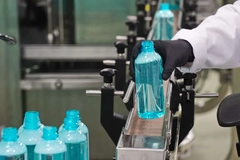US researcher develops 3D printed braille labels for clothing
A researcher from the University of Rhode Island (URI) in the US is exploring how 3D polyjet printing technology can be used to create durable, tactile braille labels for clothing. The innovation aims to make fashion more accessible for individuals with visual impairments.
Inspiration for the label emerged from research in textile science, where scientists explore ways to integrate emerging technologies into the fabric industry. 3D polyjet printing is commonly used to manufacture models, toys, and decorative elements on textiles.
Professor Izabela Ciesielska-Wrobel at URI tells Packaging Insights: “It was interesting to discover that people who have been blind since birth would like to know about the color. However, it makes sense to me because when they need to decide what to wear, they want to match colors, even if they know color matching only theoretically, to be perceived well by sighted people.”
“Nothing has changed for visually impaired shoppers in the last 50 years except for assistive tools. But when they have to go alone to buy a piece of clothing, that’s a challenge.”
Enhancing accessibility
The proposed solution involves printing braille symbols that are small enough to fit on clothing tags but sturdy enough to withstand multiple washes. Through tensile testing, Ciesielska-Wrobel confirmed that the 3D printed braille dots remained intact after washing, demonstrating the feasibility of the technique.
 Izabela Ciesielska-Wrobel, professor at the University of Rhode Island.“I tested several fabric substrates: knit fabrics versus woven fabrics, natural raw materials versus manufactured ones, and smooth surfaces versus surfaces with piles. I concluded that both knit and woven fabrics work well for small designs, such as braille dots,” says the professor.
Izabela Ciesielska-Wrobel, professor at the University of Rhode Island.“I tested several fabric substrates: knit fabrics versus woven fabrics, natural raw materials versus manufactured ones, and smooth surfaces versus surfaces with piles. I concluded that both knit and woven fabrics work well for small designs, such as braille dots,” says the professor.
She explains that the primary challenge lies in the compatibility of fabrics as “hairy” materials like knitted wool, acrylic fabrics, or blankets may interfere with the readability. “While the raw materials matter, the surface of the fabrics is more important. Fabrics that are too fuzzy or have many pills on the surface do not work well, as they may lose the print when rubbed or scratched. ”
A survey conducted by Ciesielska-Wrobel and former URI graduate student Payton Becker highlighted the difficulties faced by individuals with severe visual impairments when purchasing clothing.
The findings revealed that many visually impaired consumers struggle to make informed decisions due to the lack of accessible information on clothing tags and packaging. Standard tags typically include details such as size and washing instructions but are often too small or difficult to read.
The survey also examined respondents’ habits at home and while shopping. A majority expressed that having 3D-printed braille tags would improve their shopping decisions.
“Although they don’t see, they still take pride in their appearance. They are interested in and prioritize information about the pattern on the fabric, if there are any, along with size, color, and washing instructions,” says Ciesielska-Wrobel.
Inclusive packaging
The industry is pushing for a growing awareness of individuals with visual impairments.
Last month, Tilt Beauty introduced packaging that features braille for people with low visibility. The cosmetic brand’s packaging uses the Braille Institute’s Atkinson Hyperlegible font to improve reliability for people who are visually impaired.
Meanwhile, laundry detergent brand All Free Clear implemented NaviLens navigation technology on its packaging to help individuals with blindness and low vision. Global toy giant Mattel partnered with the American Foundation for the Blind to enhance the accessibility of the packaging for its blind Barbie doll, launched last summer, featuring braille on the front of the packaging.












